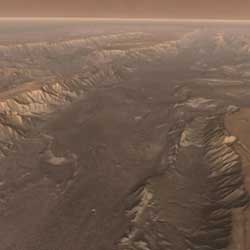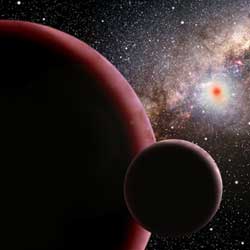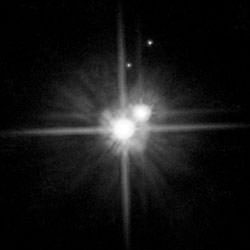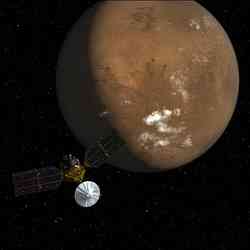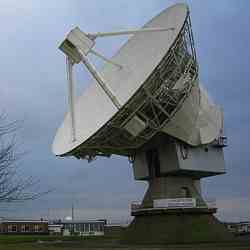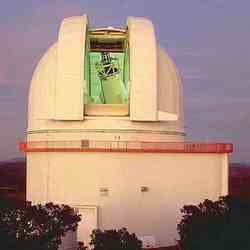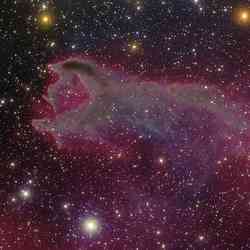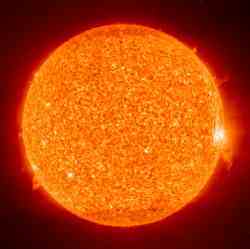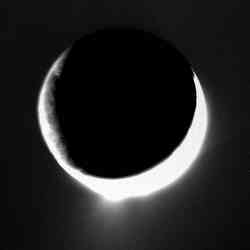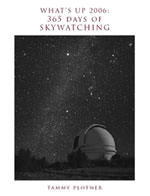
Download our free “What’s Up 2006” ebook, with entries like this for every day of the year.
|
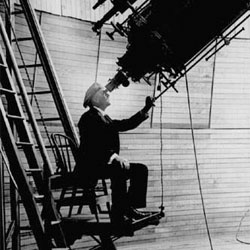
Greetings, fellow SkyWatchers! Although the Moon is back “en force”, this will still be an exciting week filled with events such as an eclipse, meteor shower and bright, beautiful star clusters.
Here’s what’s up!
Archival image of Percival Lowell. Click to enlarge.
Monday, March 13 – On this day in 1781, Uranus was discovered by William Herschel. 74 years later, in 1855, Percival Lowell was born.
Originally named “the Georgium Sidus,” Uranus was previously catalogued as a faint 6th magnitude star by John Flamsteed in 1690 and designated as 34 Tauri. Herschel came upon this same “star” – then located in the constellation Gemini – while doing a double star search using a homemade 6″ speculum-mirrored reflector. Imagine his surprise when the “star” revealed itself as a small greenish globe!
Percival Lowell was born to a distinguished Boston family with ties to Harvard University. Lowell graduated with honors in mathematics from that same institution in 1876. After traveling throughout the Far East, Lowell’s imagination was set on fire by Giovanni Schiaparelli’s observation of “canali” on Mars. In 1894, Lowell moved to Flagstaff, Arizona and established the Lowell Observatory. Over the next 15 years, he observed Mars with a passion few astronomers could ever hope to match for any single study. During this period, Lowell wrote several books developing the idea of an extinct race of Martians responsible for various artificial features he thought he had observed on the planet’s surface.
Tonight the great Grimaldi, found in the central region of the moon near the terminator is the best lunar feature for binoculars. If you would like to see how well you have mastered your telescopic skills, then let’s start there. About one Grimaldi length south, you’ll see a narrow black ellipse with a bright rim. This is Rocca. Go the same distance again (and a bit east) to spot a small, shallow crater with a dark floor. This is Cruger, and its lava-filled interior is very similar to another study – Billy. Now look between them. Can you see a couple of tiny dark markings? Believe it or not, this is called Mare Aestatis. It’s not even large enough to be considered a medium-sized crater, but is a mare!
Tuesday, March 14 – Today is the birthday of Albert Einstein. Born in 1879, Einstein was later hailed as one of the finest scientific minds of our times. In 1921, Einstein won the Physics Nobel Prize based on work completed 15 years earlier associated with the photoelectric effect – a natural phenomenon now regularly used to accumulate light to image the most distant things in the Universe. Even more significantly, Einstein developed a theory of gravity based on the curvature of space and time caused by the distribution of matter and another theory (of mass-energy conversion) which accounted for the prodigious and sustainable energy output of the stars.
Tonight is the Full Moon. In many cultures, it is known as the “Worm Moon.” As ground temperatures begin to warm and produce a thaw in the northern hemisphere, earthworms return and encourage the return of robins. For the Indians of the far north, this was also considered the “Crow Moon.” The return of the black bird signaled the end of winter. Sometimes it has been called the “Crust Moon” because warmer temperatures melt existing snow during the day, leaving it to freeze at night. Perhaps you may have also heard it referred to as the “Sap Moon.” This marks the time of tapping maple trees to make syrup. To early American settlers, it was called the “Lenten Moon” and was considered to be the last full Moon of winter. For those of us in northern climes, let’s hope so!
But for viewers almost the world over, tonight’s Moon will hold a far greater significance as it passes through a portion of the Earth’s shadow known as the penumbra. Eclipse time? You bet. For viewers in Asia, India and the western portion of Australia, you’ll get to see the Moon pass through this shadow just as it sets for your local time. For Europe and Africa? You’re in luck as the entire event can be seen from your area. For the majority of both North and South America, the eclipse will be underway as the Moon rises, but you can watch it slide out of the shadow long before it sets. Unfortunately, the western-most portion of the Americas will not see anything.
While a penumbral eclipse is not known to be particularly exciting – this one is deep. The edge of the Moon will just graze the inner umbral shadow. As a rule of thumb, remember that the Moon moves about its own diameter each hour, so the very beginning of a penumbral eclipse will be difficult to notice. Slowly and steadily, the coloration will begin to change and even inexperienced SkyWatchers will notice that something is different. It’s a very relaxing experience and we wish you clear skies!
Wednesday, March 15 – Today celebrates the birth of Nicolas Lacaille. Born in 1713, Lacaille’s measurements confirmed the Earth’s equatorial bulge. He also named the fifteen southern constellations, and a lunar feature honors his life’s work. Although the Moon will be bright, we can still have a look at the crater named for Lacaille. Start by heading towards the lunar south central region. Dominating the scene will be brilliant crater Tycho. From there, it’s north to the eastern shores of Mare Nubium, where you will see the bright ring of Thebit. Shallow Lacaille resides to the east and will be a challenge to make out under the low contrast conditions.
While skies remain bright all night, we can still have a look at an open cluster easily located in northeastern Orion. This 5.9 magnitude scattered group of stars may have been first observed by Giovanni Batista Hodierna in the mid-17th century. While bright enough to have been a Messier object, William Herschel added it to his log of discoveries on October 15, 1784, as H VIII.24. Of the 30 known stars associated with this 3,600 light-year distant group, the brightest is 50 million years old. Despite lunar interference, a half-dozen of the cluster’s very brightest members can be seen in small scopes at mid-range powers. Look for NGC 2169 slightly less than a fist width north-northeast of Betelguese and slightly south of Xi and Nu Orionis.
Thursday, March 16 – On this day in 1926, Robert Goddard launched the first liquid-fuel rocket. He first showed his potential in 1907 when a cloud of smoke rose from a powder rocket fired off in the basement of the physics building in Worcester Polytechnic Institute. Needless to say, the school took an immediate interest in the work of this student! Thankfully Robert was not expelled and a lifetime career in rocketry followed. Goddard was also the first person to realize the full spectrum of possibilities associated with missiles and space flight, and his life was completely dedicated to bringing his visions to realization. While most of Goddard’s achievements went unrecognized for many years, tonight we celebrate his name and passion for the space sciences. His first flight may have only gone 12 meters, but forty years later on this same date the Gemini 8 performed the first orbital docking – a maneuver that could have never happened without Goddard’s work!
Tonight, let’s have a look at an ancient walled plain – Gauss. Located north of Mare Crisium, this oblong crater should be divided by the terminator for most viewers tonight. Its east wall will be quite bright and the west wall outlined by a black arc. It is a very old crater, and if you up the magnification, you will see its ruined, cracked floor riddled with numerous small craterlets.
While out, be on watch for the Corona-Australids meteor shower. While the fall rate is low, about 5 to 7 per hour, our friends in the southern hemisphere stand the best chance with this one.
While we’re out, let’s have a look at another fine study on Messier’s list – M50. Described as “heart-shaped” by some observers, those with larger telescopes will see enough members of this 5.9 magnitude open cluster to note two main “petals” of stars arcing outward to the north and southeast. Several tenth magnitude stars congregate toward the center of this 3,200 light-year distant cluster while numerous 11th and 12th magnitude members dance around them in chains and arcs. Look for at least one luminous red giant and a half dozen yellow giants among this 80 million year-old, 20 light-year diameter study.
Friday, March 17 – On this day in 1958, the first solar-powered spacecraft was launched. Christened Vanguard 1, it was an engineering test satellite. From its orbital position, the data taken from its transmissions helped to refine the true shape of the Earth.
While out observing, turn a scope towards Saturn and see if you can begin to make out faint structure in the ring system. On a fine night of “seeing,” you should easily be able to make out the shadow of the planet’s globe cast the planet casts against its posterior ring plane. Look for the shadow of the ring itself softening the view of the planet’s northern equatorial region.
As the Moon rises tonight, look for bright Spica to accompany it. For some lucky viewers, this will be an occultation! Please check with IOTA for details in your area.
Saturday, March 18 – Today in 1965, the first spacewalk was performed by Alexei Leonov onboard the Soviet Voskhod spacecraft. The “walk” lasted around 20 minutes and Alexei had problems re-entering the spacecraft because his space suit had inflated. Imagine his fear as he let air leak out of his suit in order to squeeze back inside. Later when the crew of two landed off target in the heavily forested Ural Mountains, the pair had to spend the night in the woods surrounded by wolves. It took over twenty-four hours before they were located, then workers had to chop their way through the forest to recover them on skis. Brave men on the frontiers of human exploration of space!
Tonight let’s honor their courage by going after something really tough – but certainly not dangerous. Start with Castor and head 3 degrees north-northeast to center on 4.9 magnitude Omicron Geminorum. Now move north another 4 degrees to locate a widely spaced east-west oriented pair of 8th magnitude stars in the constellation Lynx. Look nearby for the faint whisper of luminosity associated with one of the most fascinating studies in the heavens – 10.4 magnitude globular cluster NGC 2419 – the famed “Intergalactic Wanderer.”
First discovered by William Herschel on New Year’s Eve 1788, the Intergalactic Wanderer may or may not just be “passing through” the Milky Way region. – Even as a member of our galaxy’s entourage of clusters and satellite dwarf galaxies, it is one of the most distant. Outside of our own galaxy at around 300,000 light-years!
Small scopists take heart. NGC 2419 can be seen on dark sky occasions in instruments as small as a spotting scope – although you will need to avert your vision to see it. How is that possible? NGC 2419 is intrinsically one of the brightest globular clusters we know of. Be sure to catch this one before moonrise!
Sunday, March 19 – With time to spare before Luna lights up the night, let’s go south and locate a fine reflecting nebula – NGC 2467 – in northern Puppis. Sometimes referred to as the “skull and crossbones nebula,” this billowing cloud of gas and dust is easily found less than a finger-width south-southeast of 3.5 magnitude Xi Puppis. Even a small telescope will find this expansive, star-studded emission nebula a real beauty! Those with larger apertures should look for neighboring splotches of nebulosity illuminated by small groupings of stars – some of which are part of a newly forming open cluster.
Keep in mind while observing NGC 2467 that we are seeing it from a great distance. At 17,000 light-years, this expansive region of star formation is some 10 times farther away than the Great Nebula in Orion. If it were the same distance away, NGC 2467 would dwarf M42!
May all your journeys be at light speed… ~Tammy Plotner. Additional writing by Jeff Barbour @ astro.geekjoy.com.
